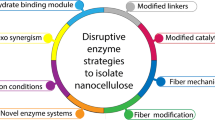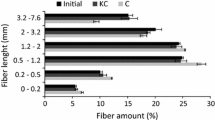Abstract
This study demonstrated the potential of simultaneously recovering cellulosic solid residues (CSR) and producing cellulose nanocrystals (CNCs) by strong sulfuric acid hydrolysis to minimize cellulose loss to near zero. A set of slightly milder acid hydrolysis conditions than that considered as “optimal” were used to significantly minimize the degradation of cellulose into soluble sugars that cannot be economically recovered, but resulted in CSR that is easily recoverable through conventional centrifuge. It was found that the window for simultaneous recoveries of CSR and producing high yield CNC in strong acid hydrolysis was extremely narrow. However, we achieved significant CSR yield with near zero cellulose loss but without sacrificing CNC yield compared with that obtained at “optimal condition”. The resultant CSR contains sulfate ester groups that facilitated subsequent mechanical nano-fibrillation to cellulose nanofibrils (CNFs), a potential high value nanocellulosic material for a variety of applications.










Similar content being viewed by others
References
Araki J, Wada M, Kuga S, Okano T (1998) Flow properties of microcrystalline cellulose suspension prepared by acid treatment of native cellulose. Colloids Surf A 142:75–82
Battista OA (1950) Hydrolysis and crystallization of cellulose. Ind Eng Chem 42(3):502–507
Beck-Candanedo S, Roman M, Gray DG (2006) Effect of reaction conditions on the properties and behavior of wood cellulose nanocrystal suspensions. Biomacromolecules 6:1048–1054
Bondeson DAM, Oksman K (2006) Optimization of the isolation of manocrystals from microcrystalline cellulose by acid hydrolysis. Cellulose 13:171–180
Chen Y, Liu C, Chang PR, Cao X, Anderson DP (2009) Bionanocomposites based on pea starch and cellulose nanowhiskers hydrolyzed from pea hull fibre: effect of hydrolysis time. Carbohydr Polym 76(4):607–615
Chum HL, Johnson DK, Black SK, Overend RP (1990) Pretreatment-catalyst effects of the combined severity parameter. Appl Biochem Biotechnol 24(25):1–14
Dong XM, Revol JF, Gray DG (1998) Effect of microcrystallite preparation conditions on the formation of colloid crystals of cellulose. Cellulose 5:19–32
Eichhorn SJ, Dufresne A, Aranguren M, Marcovich NE, Capadona JR, Rowan SJ, Weder C, Thielemans W, Roman M, Renneckar S (2010) Review: current international research into cellulose nanofibres and nanocomposites. J Mater Sci 45(1):1–33
Franson MH (1985) Standard Methods for the Examination of Water and Wastewater. 16th Ed. American Public Health Association (APHA), Washington, pp 532–537
Hamad WY (2011) Development and properties of nanocrystalline cellulose (NCC). In: Zhu JY, Zhang X, Pan XJ (eds) Sustainable production of fuels, chemicals, and fibers from forest biomass. American Chemical Society, Washington, DC, pp 301–321
Hamad WY, Hu TQ (2010) Structure–process–yield interrelations in nanocrystalline cellulose extraction. Can J Chem Eng 88:392–402
Klemm D, Kramer F, Moritz S, Lindstrom T, Ankerfors M, Gray D, Dorris A (2011) Nanocelluloses: a new family of nature-based materials. Angew Chem Int Ed 50(24):5438–5466
Marchessault RH, Morehead FF, Koch MJ (1961) Some hydrodynamic properties of neutral suspensions of cellulose crystallites as realted to size and shape. J Colloid Sci 16:327–344
Moran JL, Alvarez VA, Cyras VP, Vazquez A (2008) Extraction of cellulose and preparation of nanocellulose from sisal fibers. Cellulose 15:149–159
Mukherjee SM, Woods HJ (1953) X-ray and electron microscope studies of the degradation of cellulose by sulphuric acid. Biochim Biophys Acta 10:499–511
Nickerson RF, Habrle JA (1947) Cellulose intercrystalline structure. Ind Eng Chem 39:1507–1512
Rånby BG (1951) The colloidal properties of cellulose micelles. Discuss Faraday Soc 11:158–164
Revol J-F, Bradford H, Giasson J, Marchessault RH, Gray DG (1992) Helicoidal self-ordering of cellulose microfibrils in squeous suspension. Int J Biol Macromol 14:170–172
Saito T, Okita Y, Nge TT, Sugiyama J, Isogai A (2006) TEMPO-mediated oxidation of native cellulose: microscopic analysis of fibrous fractions in the oxidized products. Carbohydr Polym 65:435–440
Stamm AJ (1964) Wood and cellulose science. The Ronald Press Company, New York, p 549
Wegner TH, Jones EP (2009) A fundamental review of the relationships between nanotechnology and lignocellulosic biomass. In: Lucia LA, Rojas OJ (eds) The Nanoscience and Technology of Renewable Biomaterials. 1 st ed. John Wiley and Sons, USA, pp 1–41
Zhu JY, Sabo R, Luo X (2011) Integrated production of nano-fibrillated cellulose and cellulosic biofuel (ethanol) by enzymatic fractionation of wood fibers. Green Chem 13(5):1339–1344
Zhu W, Houtman CJ, Zhu JY, Gleisner R, Chen KF (2012) Quantitative predictions of bioconversion of aspen by dilute acid and SPORL pretreatments using a unified combined hydrolysis factor (CHF). Process Biochem 47:785–791
Acknowledgments
Financial support for this work included USDA Agriculture and Food Research Initiative (AFRI) Competitive Grant (No. 2011-67009-20056) and Chinese Scholarship Council (CSC). The funding from these two programs made the visiting appointment of Wang at the USDA Forest Products Laboratory (FPL) possible. We would like to acknowledge Fred Matt and Kolby Hirth (Both FPL) for conducting carbohydrate and sulfur content measurements, respectively, Thomas Kuster (FPL) for SEM image analysis, Debby Sherman of DSimaging and Life Science Microscopy Facility at Purdue University for TEM analysis of the mechanically fibrillated CSR samples. We also would like to thank Anne Kamata, SAIC-Frederick, Inc. for electron microscopy imaging. The TEM imaging work has been funded in whole or in part with federal funds from the National Cancer Institute, National Institutes of Health, under Contract No. HHSN261200800001E. The content of this publication does not necessarily reflect the views or policies of the Department of Health and Human Services, nor does mention of trade names, commercial products, or organizations imply endorsement by the U.S. Government.
Author information
Authors and Affiliations
Corresponding author
Additional information
This work was conducted on official government time of Zhu, Reiner, and Verrill. Wang was a visiting student at the USDA Forest Service, Forest Products Laboratory.
Rights and permissions
About this article
Cite this article
Wang, Q.Q., Zhu, J.Y., Reiner, R.S. et al. Approaching zero cellulose loss in cellulose nanocrystal (CNC) production: recovery and characterization of cellulosic solid residues (CSR) and CNC. Cellulose 19, 2033–2047 (2012). https://doi.org/10.1007/s10570-012-9765-6
Received:
Accepted:
Published:
Issue Date:
DOI: https://doi.org/10.1007/s10570-012-9765-6




